It might sound romantic to some, a night in the Sahara, with the sand dunes as your pillow and the stars forming a canopy over your head. To others, the idea of sleeping in the frigid night, with the sand crunching in between your teeth, the camels galloping around in the background, and the people in the next tent rustling might not be the best way to spend the evening, when a proper hotel with a proper bed and shower might only be a couple of miles away. It's really a matter of perspective. Except that the full moon is actually really bright, especially if you're used to sleeping in the dark.
I actually didn't end up sleeping well, but I still have to say it's quite an experience to see the camels running around under the light of the moon in the middle of the night. Early in the morning we hiked back up to the top of the tall sand dune, to watch the sun rise. There were some clouds on the horizon, so we missed the actual event, but soon after the sun, higher in the sky, rose about the clouds and made the reddish brown sand resplendant in every direction.
Jason had brought his Bible up, and had his own moment on top of the dunes.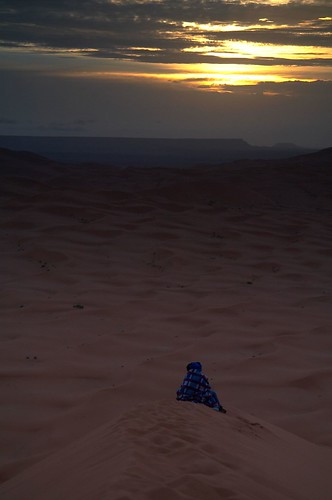
We returned to the breakfast at the camp, and quickly packed up for a camel ride back out. Back at the hotel in Marzouga, we had to wait a little while for our driver. In the meantime we had a chat with one of the camelmen, Moha, a Berber who had been working as a camel guide into the Erg for quite some time. He was trying to trade his Berber shoes for our Nikes.
From the hotel we heade back to Erfoud on the Land Rover, where we got back into our grand taxi to head to Marrakesh. The return trip was two days of mostly driving. We'd start from Erfoud and briefly visit the Todra Gorge, then stay in a town called Tinghir. The next day we'd make our way first to Ourzazate, then over the mountains to Marrakesh. Although long, I'd have to say it wasn't a dull drive as we watched the scenery change from desert wasteland to patches of oases, then to mountain and then back down to plains.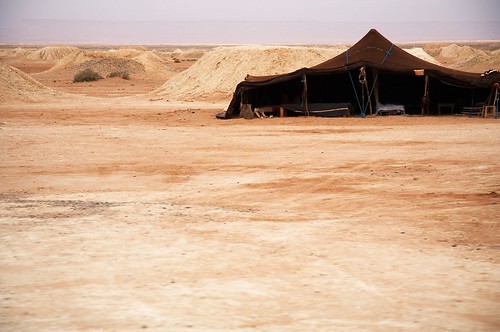
Our drive to the Todra Gorge and Tinghir was not too eventful. Of primary interest were small town after small town that we passed through as we made our way through the edge of the Sahara. Little towns, almost clones of each other from our foreign perspective, repeated themselves, with the same architecture of pink buuldings, the same storefronts, the same donkey carts and women enshrined head to toe in black. The people we had met in Casablanca were all working to create businesses that would allow them a work visa. Out here in these villages though, the chances of seeing any spiritual influence other than Islam seems dim, unless perhaps some organizations working to alleviate the poverty might show up. In the towns out here, many of the working men are seasonal labourers in Europe, hopefully sending some of their earnings back to their families.
The Todra Gorge is indeed a rather impressive gorge with sheer walls rising up some 300+ feet. we walked along the river at the bottom, and noticed foreign rock climbers who had come to conquer the stone walls. There's a tourist village of restaurants and services at the bottom of the Gorge. The overall size isn't that impressive when compared to features like the Grand Canyon, but it was a nice stop during the day of driving. When we made it to Tinghir, Jason went to bed, struggling with whatever bug was still having its way with his insides. Driss took me to another "artisan exhibition" of Berber goods, where the same process of "buy or no buy, we are still friends", "don't buy one, buy more, I'll give you a good price", and "I'm sorry, but you have expensive tastes" was repeated.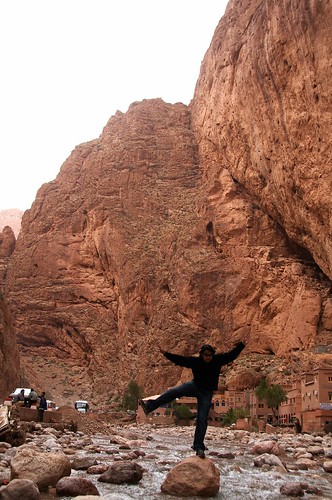
The food at the Hotel Kasbah Tizimi in Tinghir was actually very good (had cous cous, with harissa, the local hot sauce). Since Jason stayed in bed, I ended up having dinner with Driss, we danced around topics of religion, family, filial piety, and why one ought to buy presents for ones parents when travelling. I have to say, the Muslims here certainly have their religious faith and everyday breadwinning tightly integrated. The oddity of this fairly comfortable hotel was the shower, where botht he toilet and shower sat behind the shower curtain that stopped about a foot off the ground, guaranteeing a good sized pond in the bathroom after a shower.
The next day was November 7, and as we came out of our hotel room located on the rooftop, we noticed that it was wet out, and it had been raining during the night. As we made our way towards Ourzazate, there were occasional spots where a stream from the rainfall had overrun the road. We'd see a section of asphalt ahead disappear under reddish brown rippling waters. Luckily our car was able to navigate over all these instances. Locals continued about their business in the rain, and on more than one occasion we saw women in hajib walking along the highway with baskets balanced on their heads despite the rain and wind.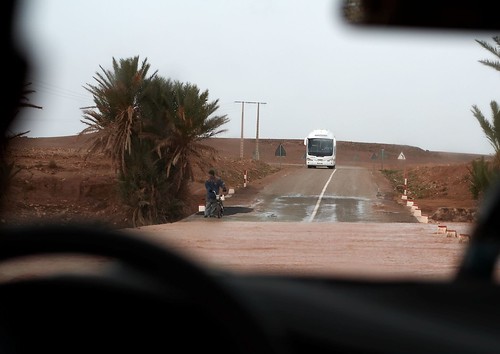
We stopped briefly in Ourzazate to see casbah that had once belonged to some wealthy chieftan near the early 20th century. The town of Ourzazate is home to a thriving film industry. There are a number of studios with soundstages here, and a lot of moviemaking is done in the desert-like countryside. After the casbah, it was a short drive to Ait Ben Haddou, a classic looking Berber village built up the side of a hill. The locals were rather proud that part of the Gladiator was filmed here.
It was still raining at this time. As we got out of the car and walked towards the village, it was clear that a rushing river blocked our path. Some entrepreneuring locals with horses stood by the river, offering a ride across the rushing waters. We took up the offer (it only ended up being 50 drms total for the 3 of us). On the other side, the ground was a bit muddy, but turned to rock on the way up. The village was pretty quiet. There are few locals that live there, and the ones that do run various shops for tourists. I did notice a woman on a loom weaving a rug through an open doorway. There were few other tourists given the rain, and we made our way all the way to the top of the hill (despite our guide giving up at the top of the village). There were only ruins at the top, but it was clear that at one point, this hill had been a commanding location. One could see in miles in all directions, with a clear view of the river and the plains below.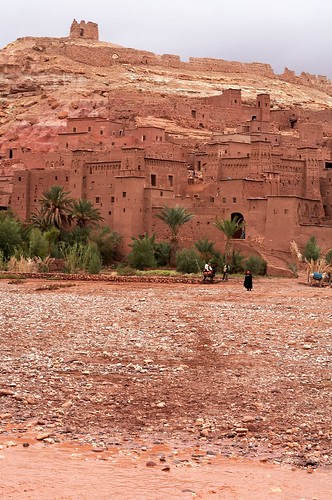
The rain let up as we left Ait Ben Haddou and headed into the High Atlas mountains (a different mountain range than the Middle Atlas we had passed through on the way from Fes to Erfoud). The hills near Ourzazate grew into towering mountains with deep valleys. The towns changed from the pink buildings of the Saharan villages to terraced Berber houses, where the entrance of one house would be on the roof of the one below it, much in the same ancient style of Ait Ben Haddou. In the larger towns, minarets would tower above the town, the central landmark much like the way church spires stood in small European villages.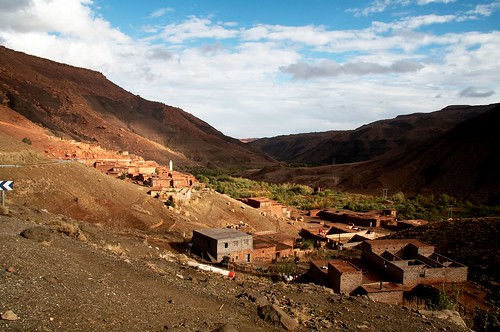
The missed photograph was a brilliant quarter rainbow against the mountainside, as light streamed through the clouds, painting spots on the rock face that dropped hundreds of feet into a valley below.
We had a brief stop for Berber omlettes (eggs in a tagine pot, cooked with spiced oil and cumin), and some sort of Berber porridge for Jason, and from there we started the descent in the winding, mountain roads, somewhat treacherous in the rain that was occasionally starting and stopping. 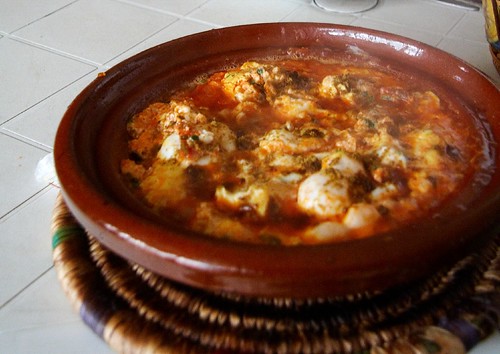
As the sun set, we hit the foothills and eventually the plains. The drive was now treacherous in the dark, with nothing to light the roads, not even the reflectors we're used to in California. The road no longer contained hairpin turns, but even around the wider turns, there was always the danger of seeing a donkey cart loom up instantly in the headlights. Passing cars on the two lane highway was occasionally frightening, but eventually we saw the signs of civilization grow as we slowly made our way into Marrakesh. The lights in the distance closed in, and eventually we crossed the outer walls, and made our way into the medina, the old city, and towards the Djmaa El Fna, the famous city square that defines Marrakesh. Our hotel, the Riad Omar, was located right off the pedestrian square. After the extended ride, I couldn't wait to explore the bustling medina.
Nov 13, 2006
Crossing the River
Subscribe to:
Post Comments (Atom)
No comments:
Post a Comment